- Home
- Alison McGhee
Snap Page 2
Snap Read online
Page 2
“I don’t,” Sally said. “Not anymore.”
“What?”
“I don’t dream of s’mores,” Sally said. “They’re too sweet.”
“Did you just say something is too sweet?”
“Yes.”
“Since when?”
“Since right now.”
“You’ve got to be kidding me,” I said. “What about ice cream? What about brown sugar on oatmeal? What about blueberry pie?”
No answer. It was late in the afternoon. To the west the sun was sinking below the rounded humps of the Adirondacks. Sally rubbed her sticks together furiously.
“Are you saying you’ve become an anti-sugarist?” I said.
“Sugar’s bad for you.”
“But what about chocolate-covered sprinkle doughnuts?”
“I will never eat another chocolate-covered sprinkle doughnut,” Sally said.
She tossed her sticks into the grass and went up on the porch to get her jump rope. She went out to the dirt jump-rope patch under the maple and started practicing her Rope Power routine: cancan, double under, grapevine.
Up until I was eight or nine, well past the age of reason, I used to think that Sally lived with her grandmother because Jill, her mother, doesn’t talk. Maybe I assumed that children weren’t allowed to live with their mothers if their mothers didn’t talk. Then one day it dawned on me that other parents — blind parents, deaf parents, parents who don’t have any legs or any arms — still live with their children.
Sally’s mother’s name is Jill. She lives in Remsen, in an apartment next to the blacksmith. She works in Remsen too, at BJ’s Foods. Jill’s checkout lane is lane 3, and when I was little, I always told my mother to go to lane 3 if Jill was working there. Lollipops is why. She had a small cardboard box filled with them: grape, lime, orange, lemon, and cherry. After she finished checking and bagging the groceries, she would pull out the little box and hold it up in the air, looking at my mother with a questioning look.
“Please, Mom?” I used to say. “Please?”
My mother used to nod, and then Jill would lower the box to my height, so that I could see into it and pick. Lime, that was my favorite. And it must not have been any other kid’s favorite, because there were always plenty of green lollipops to choose from.
“What do you say?” my mother used to say.
“Thank you, Jill,” I would say back.
Most people would have said, “You’re welcome,” back to me. “Thank you” calls for “you’re welcome.” But not Jill. Jill doesn’t talk.
Perhaps Sally and Willie also chose lane 3 so as to see Jill. Perhaps Sally used to say hello to her mother, years ago, before the age of reason. Had her mother ever said hello back? Had her mother ever held out the box of lollipops to Sally?
“Jill was very young when she had Sally,” my mother told me when I asked her about the situation.
“How young is very young?”
“Fifteen, I think.”
When you’re fifteen, you’re still in high school. You haven’t even reached your full height when you’re fifteen. You have a couple years of growing left.
“Jill wasn’t able to take care of Sally by herself,” my mother said.
“Is that because she doesn’t talk?”
“No,” my mother said. “Or maybe it is, in a way. Things have always been hard for Jill. Jill doesn’t seem equipped for the world.”
Sometimes I wonder if Sally misses the sound of her mother’s voice. Sometimes I wonder if she ever even heard her mother’s voice. If you’ve never heard something, like the sound of your mother’s voice, would you miss it anyway?
“Wilhelmina was very strong,” my mother said. “I don’t recall her ever saying one chastising word about the situation. She just took over and made a good life for Sally.”
Wilhelmina is Willie’s proper name, although everyone except my mother calls her Willie. But my mother believes in full names, which is why she calls me Edwina and why she goes only by Mildred. It’s not a common name these days, Mildred. Some might even say that it’s an ugly name. But my mother is not ugly. My mother, were she being born today, wouldn’t be named Mildred. She would be named Ashley, maybe, or Gillian, or Samantha. Does she care? No.
“It’s my God-given name” is what she says, “and my God-given name is what I want to be called.”
Even my father, who loves her to the ends of the earth, calls her Mildred. My mother is a nicknameless person to everyone but me. I call her Mom.
Sometimes Sally and I play a game we call Blind. One of us closes her eyes — squinches them shut so that no light comes in — and the other takes her arm and leads her around. “Come on,” we say to each other, “it’s all right.” At first it feels wrong, walking around with my eyes closed. But after a while I focus on Sally’s arm and her voice. “Mud puddle coming up,” she’ll say. “Step to your right.” Or “Rock straight ahead; follow my lead.”
Sometimes she’ll slip something into my hand, a cellophane-wrapped mint from the basket at the Café Nero cash register, for example, or a leaf. “Tell me what kind of leaf this is,” she’ll say. “No peeking allowed.”
I’m good at figuring out what the things she gives me are. Leaves especially; maple leaves most especially. If you play Blind often enough, your fingers get used to sensing what something really is, its true shape.
Sometimes Sally and I jump rope blind. You can’t think about it too much or you’ll get stuck. You just have to close your eyes and begin.
Sally, who’s on the Rope Power team at school, practices all her tricks blind: rocker rebound forwards, crisscrosses, bleakings, and double unders. I’ve watched her go from not being able to do a double rebound forward, which is the easiest of all Rope Power tricks, to doing a crisscross, which is not so easy, to a backward crisscross, which is hard, to a three-sixty, which is harder. I’ve seen her land a cancan, and I watch her now, working on a grapevine, which is the final and most difficult Rope Power trick. And she does them all blind. Sally is known at school as an expert rope-jumper.
“You can’t think about it,” she says. “That’s the key.”
Few people know this about Sally, but when we were very young, she used to be scared to jump rope. We were at my house doing dares: eat this lump of Play-Doh, eat this spoonful of nutmeg, eat this, eat that. Then we moved into physical dares. Leap from the recliner to the couch! Jump from the fourth stair to the bottom!
“Jump, Sally!” was what I remember saying that day that we were daring each other.
But she couldn’t. She couldn’t jump at all. That was something I didn’t know about Sally back then, how scared she was to jump over anything. Finally I coiled up my jump rope, my rainbow-colored rope with red plastic handles, and lessened the dare to just that: jump over the jump rope, lying on the rug in a little coiled lump. She looked down at the rope at her feet, curvy and still like a snake sleeping in the sun, and she started to cry.
“I can’t,” she said.
Her hair was short then, the same dark brown it is now, and Willie had put a purple barrette in it that day. The purple was barely visible against the darkness of her hair, but there was a row of tiny rhinestones on the clasp, and when her head moved, the rhinestones caught the light and winked. She was crying, and I remember how strange it seemed that she could be so sad and so beautiful at the same time, with the sunlight striking and sparking off her dark head the way it did that day.
She couldn’t see how beautiful she looked, but I could. You’ll never be able to see your own face. Have you ever thought about that? When you’re looking in the mirror, you’re not seeing your own face in real life. You’re seeing a reflection. The backward image of yourself.
I never thought about this until I caught sight of my own reflection in that restaurant in Utica. It was then that I saw how I covered my mouth when I laugh, and what an irritating habit it was.
Even though I’m not always aware of covering my mouth when I laugh
, I snap my white rubber band often, just for good measure.
“Edwina, please don’t store food in your cheeks,” my mother said.
My mother and I were eating supper from paper plates while sitting around the kitchen table, an indoor semi-picnic. It was one of the weeks, which are every other week, when my father was on the road. He’s a salesman. It was early summer and the windows were wide open. Bumblebees kept buzzing up against the screens.
I snapped my red rubber band.
“My daughter, the chipmunk,” my mother said. “Swallow.”
I swallowed. My wrist stung.
“Edwina, please don’t tip back in your chair,” my mother said.
I snapped my yellow rubber band. My wrist stung worse.
“You sound like Sally’s grandmother,” I said.
“I do? In what way?”
“‘Never tip back in a chair,’” I recited, “‘because you might end up like my friend Sara on the day we graduated from high school.’”
“Which is how?”
“Dead.”
“Oh,” my mother said. “My.”
She reached up to the cupboard above the stove, the cupboard where the hammer and nails are kept, and she pulled down a glass baby-food jar filled with eight-penny nails.
“Mom, is Willie all right?”
Red flag. I could see it immediately. My mother’s back stiffened. I waited for her to set the jar on the counter. I knew that she would answer me. She always does. She’s never lied to me, my mother.
She turned and faced me. Her fingers were still gripped over the top of the eight-penny nail baby-food jar. She looked right at me.
“Mom? Is Willie all right?”
“No.”
I waited. She was still looking at me. I had the feeling that my mother wanted to lie to me. That if she could’ve, she would’ve.
“What’s wrong with her?”
“She’s sick.”
“What kind of sickness?”
“She has a disease that’s harming her blood.”
“Will she get better?”
“No.”
I waited then. I waited for my mother to tell me something that would take away the way the word no sounded, hanging in the air of the kitchen the way it did. There must be something she could say that would take away the sound of that word, and I waited for her to say it.
“She won’t?”
That’s what I finally said.
My mother shook her head. Her eyes darkened the way they sometimes do, the way they do when she has to do something she doesn’t want to do.
“I’m sorry,” she said.
That was all she said.
“Are you sure?” I said. “Because Sally’s only eleven.”
My mother nodded. She knew exactly what I was talking about, Sally and her elevenness. She stood there in the kitchen, with the little jar of eight-penny nails behind her, nodding. In my mind I could see Willie sitting with us at her kitchen table, eating her way through a stack of doughnut holes while Sally sat laughing on her lap, half a sprinkle doughnut in each hand.
“She needs her grandmother,” I said. “She needs her.”
My mother kept nodding.
I started snapping my purple rubber band. My mother stood there for a long time, and I sat there snapping, and the fluorescent light above our heads was semi-blue and after a while I could hear its faint buzzing.
Sometimes, in school or riding the school bus or in the grocery store or walking the two sidewalks of Sterns, here where I live in the foothills of the Adirondacks, I look at the girls passing by and think, Who did her hair?
I notice hair. The hair I want is hair like Sally’s, long curly hair that swoops over my shoulders and down my back. My own hair is colorless — not-brown, not-blond — and grows slower than anyone else’s I know. Last Thanksgiving I decided to grow my bangs out.
“Oh, you’re growing out your bangs?”
I looked forward to having my friends ask me that question. There’s a certain way that girls ask that question of someone who has straight hair and is in a bangs-growing stage. They tilt their head a bit; they nod knowingly. Everyone knows what it’s like. It’s a difficult thing.
But I looked forward to it. I looked forward to the day when I would be able to sigh and roll my eyes and pull dramatically on my used-to-be-bangs.
And I’m still looking forward to that day.
Because my bangs have still not grown out enough to have a single person tilt her head and ask me sympathetically, “You’re growing out your bangs?”
My hair has not even needed to be trimmed.
Unlike Sally’s hair, long and dark brown with red that glows when the sun is shining on her head. Left undone, Sally’s hair rises around her head like a halo in the sunshine. When she jumps rope, her undone hair floats behind her, bouncing in rhythm to her strides. When Sally is in the haymow and the sun is shining through the unpaned window, dust motes rise around her haloed head.
The first day I met Sally, which was the first day of second grade, in Mrs. Lattimore’s class, the sun shone and sparkled on her hair. I looked at her long braids, glinting red and brown, and wondered if she had done them herself. I had been growing out my own hair all summer, but it grew so slowly that even I couldn’t tell the difference. Sally had the hair I had always wanted.
Sally had just transferred from Remsen Elementary, the next school north. There she was, with her long auburn braids, holding her grandmother’s hand. Our names were Magic Markered in uppercase, big and black and bold, on scissored rectangles of masking tape affixed to one of the tables near the back of the classroom.
SALLY HOBART
And me, also in uppercase black:
EDWINA BECKEY
Next to our table were (1) stacked plastic storage boxes filled with markers, crayons, colored pencils, glue sticks, scissors, stencils, and colored pipe cleaners, (2) the bathroom with its open door, low toilet, and low sink, (3) a long row of hooks, large ones for coats, smaller ones for backpacks, (4) a row of cubbies, each with an orange construction-paper nametag leaf taped to it, each holding a newly sharpened pencil, and (5) a cage holding what at that point I did not know was a hedgehog.
All I knew was what the animal I was staring at wasn’t: a cat, a raccoon, a ferret like the kind I remembered seeing in a pet shop, a rat, a donkey, an elephant, a giraffe. At that point the hedgehog was just a nameless semi-porcupinelike animal.
That’s because I was a second grader, lacking knowledge. Second graders are just a few years out of toddlerhood, when you think about it. The age of seven is known as the age of reason, but for most seven-year-olds reason has yet to come.
Mrs. Lattimore spoke softly, but the way she shook her head when her black curls got into her eyes made me tense.
“Any questions so far?”
I raised my hand. I wanted to know what was in that cage.
“Yes, Edwina?”
“Eddie,” I said.
She raised her eyebrows. “Eddie is your nickname?”
Nod.
“You prefer Eddie to Edwina?”
Nod.
She looked at me. There was something in that look, and I felt that something, and I put my hand down. There was silence in the second-grade room.
“Well, Eddie, thank you for that information.”
I looked at the table. SALLY HOBART was silent. But when Mrs. Lattimore turned back to the board, Sally reached out to EDWINA BECKEY and carefully ripped off the WINA so it just read ED BECKEY.
Sally leaned toward me, her braids brushing the table, and whispered, “Hi, Eddie.”
Every day, Willie does Sally’s hair. The middle drawer of Sally’s desk at her house is her hair drawer. Here is a list of Sally’s hair ornaments:
1. Ponytail holders, large and small — glittered, neon, multicolored, lacy, beaded, sequined.
2. Barrettes of all shapes and sizes.
3. Tortoiseshell combs — to clip her hair back in their
tortoiseshell teeth.
4. Chopsticks — to be thrust through a bun.
5. Hair bands.
6. Bandanas.
7. Tiny butterfly clips — which Willie arranges all over Sally’s head when her hair is loose.
“But who’ll do her hair?”
That’s what I asked my mother that night we were standing in the kitchen with the buzzy fluorescent light above us and the little glass jar of eight-penny nails behind her.
“Sally can probably do her hair herself by now, don’t you think?”
I stared at her. Had she never in all these years noticed Sally’s hair? Had she not seen the way one day it would be French-braided in a coronet around her head, and the next, in a ponytail that began at the top of her head with just a few strands of hair and then went all the way down the back of her head — gathering in hair as it went, secured with six ponytail holders of different, complementary colors — and the next, in a two-strand weave? Had she not seen the way the butterfly clips twinkled in the sun when Sally was practicing her jump roping?
“No,” I said. “No, Mom, she can’t do her hair by herself.”
This past year we studied pack rats in earth science. Mr. Tyler created a midden heap for us in an unused desk well.
Mr. Tyler shone his pocket flashlight into the darkness of the unused well, revealing a little pile of things he had assembled: an acorn cap, some peanuts, half a broken comb, a silver thimble, a pinecone, and a clump of hair that looked as if he’d pulled it out of his wife’s or daughter’s hairbrush, because it was long and brown, not short and gray like his.
“Sixth graders, this is a representation of a pack rat’s midden heap,” Mr. Tyler said. That was what he always referred to us as: sixth graders.
The thin beam of light from his pocket flashlight glinted off the silver thimble.
“Are pack rats generally known for their sewing ability?” Tracy Benova asked.
“Pack rats like shiny objects,” Mr. Tyler said.
He was used to Tracy’s questions. Mr. Tyler played his flashlight beam around the rest of the dark desk well. Ancient chewing gum was stuck to the underside of the desktop.

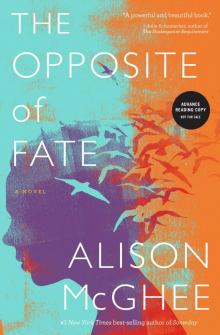 The Opposite of Fate (ARC)
The Opposite of Fate (ARC)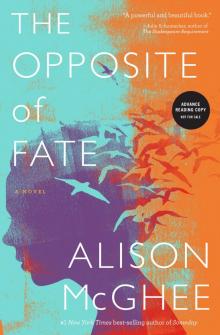 The Opposite of Fate
The Opposite of Fate What I Leave Behind
What I Leave Behind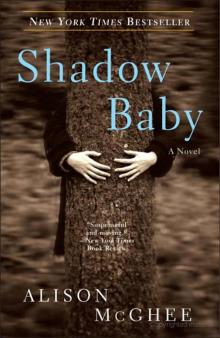 Shadow Baby
Shadow Baby All Rivers Flow to the Sea
All Rivers Flow to the Sea Was It Beautiful?
Was It Beautiful?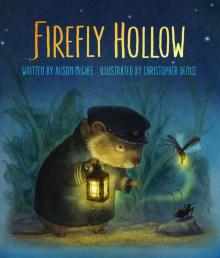 Firefly Hollow
Firefly Hollow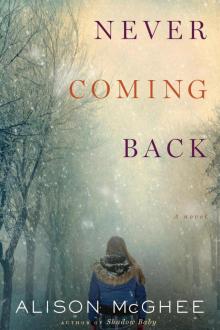 Never Coming Back
Never Coming Back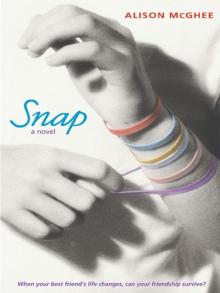 Snap
Snap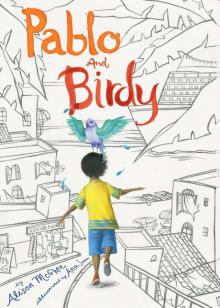 Pablo and Birdy
Pablo and Birdy